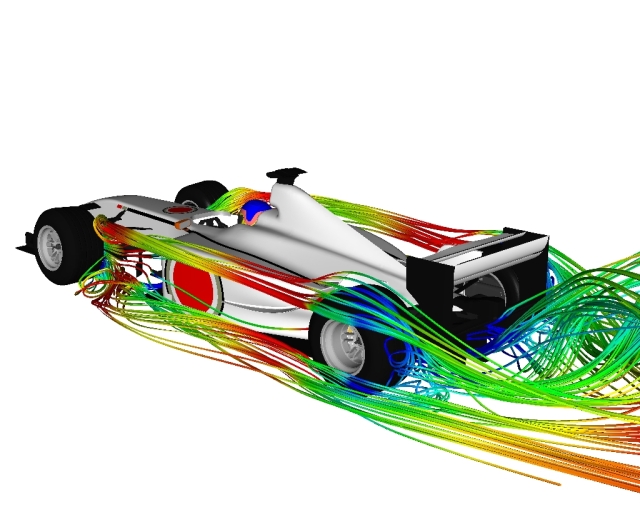
Car Design and CFD
I've noticed a flurry of announcements that cite the use of Computational Fluid Dynamics (CFD) in the design of new cars for public roads and race tracks. While none of these announcements say that CFD was responsible for the design of the whole car, equally they don't say, with much clarity, what exactly did CFD contribute?
Some of the recent statements about CFD use in car design:
- Jaguar XF, "...for the first time on any Jaguar, the entire body was developed using Computational Fluid Dynamics (CFD) before the car ever saw a wind tunnel"
- Mazda Furai Concept, "The team used complex Computational Fluid Dynamics (CFD) software to tune various Nagare design elements to function at a high degree of efficiency."
- Ford GT500KR, "Developed through intensive use of analytical tools including Computational Fluid Dynamics (CFD) and Finite Element Analysis (FEA)..."
- BMW M3 Racer, "These include computational fluid dynamics (CFD) and wind tunnel analyses, both of which have ensured the best possible aerodynamic package for the BMW M3."
The most revealing insight was for the new Saab 9-3 Sport Sedan and SportCombi, "Advanced CFD (Computational Fluid Dynamics) modeling played a vital role in the visualization of airflow and facilitated optimization work in the wind tunnel. CFD was also the main tool for analyzing internal airflows: in the engine bay."
So with a view to setting the record straight, here's my take on what CFD likely contributed to the design of these cars.
CFD Strengths
The major strength of CFD compared to other methods of design analysis, such as wind-tunnels, is the ability to produce and analyze the entire velocity, temperature and pressure fields around a car. CFD results, combined with advanced 3D visualization, can show contours, iso-surfaces, vectors and streamlines of these field variables (for examples see our Caedium product description). Such visualization techniques go a long way to revealing the processes behind key performance characteristics, such as downforce and drag for external car aerodynamics. With a better understanding of how the airflow around a car develops, it is possible, though still not easy, for designers to make geometry changes with the intent of improving the aerodynamic performance of a car.
The visual impact of 3D airflow visualization has also caught the eye of car marketing departments and often finds its way into marketing material.
CFD is also capable of predicting key performance characteristics, such as downforce and drag, relatively accurately. Given these characteristics as a measure of aerodynamic performance CFD can be used to drive Multidisciplinary Design Optimization (MDO) processes (in either an automated-closed-loop or man-in-the-loop mode) that vary geometry parameters in search of an optimal aerodynamic and structural configuration.
CFD Weaknesses
CFD, like all analysis tools, has strengths and weaknesses. Full Reynolds-Averaged Navier-Stokes (RANS) CFD simulation setup (geometry capture, cleanup and meshing) and run-times can be significant (days to weeks), especially if analyzing a series of small changes such as an alpha sweep on a rear wing within the context of a detailed, full-car simulation. In fact, a wind-tunnel can often be a timelier method for obtaining results, made possible by advances in rapid-prototyping. Often CFD and wind-tunnels are considered complimentary analysis tools, rather than competitors. Many car designers use both forms of analysis in search of an optimal design. In Formula 1, for instance, CFD and wind-tunnels are allocated equal status in the form of extensive budgets - for computing and software resources in the case of CFD, and facilities in the case of wind-tunnels.
 CFD in F1Symscape does not hold the copyright on this picture
CFD in F1Symscape does not hold the copyright on this picture
Next Time
So when the next press release for a new car cites the use of CFD in its design, you'll know why and how. Of course, if they simply showed a picture of the simulation results it would be obvious why CFD was used
Recent blog posts
- CFD Simulates Distant Past
- Background on the Caedium v6.0 Release
- Long-Necked Dinosaurs Succumb To CFD
- CFD Provides Insight Into Mystery Fossils
- Wind Turbine Design According to Insects
- Runners Discover Drafting
- Wind Tunnel and CFD Reveal Best Cycling Tuck
- Active Aerodynamics on the Lamborghini Huracán Performante
- Fluidic Logic
- Stonehenge Vortex Revealed as April Fools' Day Distortion Field

Comments
Aptera Used CFD Too
Aptera Concept, "...we refined the Aptera's shape to maximize efficiency using CFD (Computational Fluid Dynamics)"
Aptera is also a likely competitor in the Automotive X Prize.
Audi Motorsport Is Doing It Too
Audi A4 DTM, "With the help of state-of-the-art CFD calculations (Computational Fluid Dynamics) particular attention was paid to the air flow running around and through the car."
Buell Motorcycles Joins the CFD Party
2008 Buell 1125R, "The cowlings have an internal vane (splitter) to split airflow efficiently and were designed with computational fluid dynamics (CFD) models to optimize air flow at all speeds..."